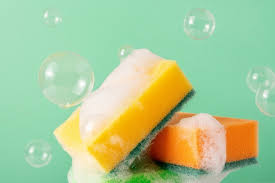Sponges and soap are staples in most households, used daily to clean dishes, surfaces, and even ourselves. But have you ever wondered how this simple combination works so effectively to remove dirt, grease, and grime? The science behind soapy sponges reveals a fascinating interplay of chemistry, physics, and material science.
The Role of Soap: Breaking Down Dirt and Grease
At the heart of a soapy sponge’s effectiveness is soap, a surfactant made of molecules with two distinct ends—a hydrophilic (water-attracting) head and a hydrophobic (water-repelling) tail. These dual properties make soap uniquely capable of breaking down grease and dirt.
When you add soap to water, the hydrophobic tails of the soap molecules avoid water and attach themselves to grease or oil. Meanwhile, the hydrophilic heads remain in the water. This action forms structures called micelles, where the grease and oil are trapped inside, surrounded by the hydrophilic heads. These micelles allow greasy substances to be rinsed away with water, leaving surfaces clean.
Sponges: The Perfect Cleaning Tool
Sponges are made from porous materials that can absorb water and hold soap. This absorbency is key to their cleaning power. The sponge’s porous structure creates a large surface area that helps scrub and lift particles of dirt and grime. Additionally, the flexibility of sponges allows them to conform to different surfaces and crevices, making them effective for cleaning irregular shapes and hard-to-reach spots.
Modern sponges are typically made from synthetic materials like polyurethane or cellulose, both of which are durable and hold up well under frequent use. Natural sponges, made from the skeletons of sea-dwelling animals, have been used for centuries and are still valued for their softness and high absorbency.
The Chemistry of Foam
Foam is another critical aspect of how soapy sponges clean effectively. When you agitate a sponge with soap and water, bubbles form, creating foam. Foam increases the surface area of the soap, allowing it to come into contact with more dirt and grease. The bubbles also help to lift particles off surfaces, making it easier to scrub them away.
The physical action of scrubbing with a sponge creates friction, which further aids in dislodging stubborn grime. Combined with the chemical action of soap, this process ensures thorough cleaning.
Water Temperature: A Crucial Factor
The temperature of the water you use can significantly impact the effectiveness of a soapy sponge. Warm water helps soap dissolve more easily and lowers the surface tension of water, making it better at spreading over surfaces. Warm water also softens grease, making it easier for the soap to break it down and for the sponge to scrub it away.
However, overly hot water can damage certain sponges, particularly those made from synthetic materials. It’s essential to strike a balance to achieve optimal cleaning results without compromising the longevity of your cleaning tools.
Antibacterial Properties of Soap and Sponges
Many modern soaps and sponges come with added antibacterial agents to inhibit the growth of bacteria. This feature is especially important because sponges, by nature of their absorbency, can become breeding grounds for microbes. Regularly rinsing and wringing out your sponge, as well as replacing it periodically, can further reduce the risk of bacterial contamination.
Environmental Considerations
While soapy sponges are incredibly effective, their environmental impact is worth noting. Synthetic sponges can take years to decompose, and some soaps contain chemicals that are harmful to aquatic ecosystems. Opting for biodegradable sponges and eco-friendly soaps can mitigate these effects, allowing you to clean effectively while minimizing your environmental footprint.
The Science of Cleaning in Everyday Life
Understanding the science behind soapy sponges gives us a greater appreciation for these everyday tools. The combination of soap’s chemical properties and the sponge’s physical structure creates a powerful cleaning duo capable of tackling a variety of messes.
